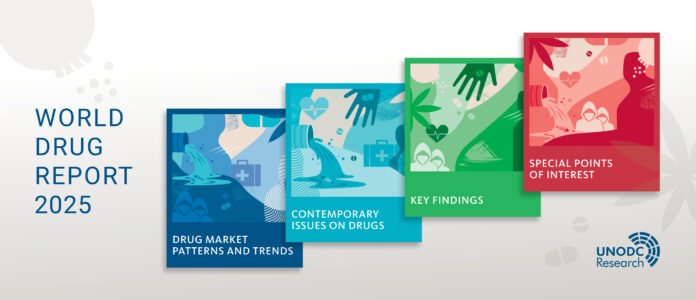Introduction
The UNODC World Drug Report 2025 presents a critical analysis of the current global drug landscape, characterized by escalating challenges that have been significantly influenced by recent periods of instability. The report highlights that the drug trade is not merely a criminal issue; rather, it intersects with social, economic, and health-related challenges. Ghada Waly, the Executive Director of the United Nations Office on Drugs and Crime (UNODC), underscores that the complexities surrounding drug use and trafficking require multifaceted solutions that extend beyond punitive measures.
One of the most striking observations from the report is the continuing rise in drug use, which has been exacerbated by the socio-economic ramifications of the Covid-19 pandemic. The pandemic has altered access to treatment and rehabilitation services, making it increasingly difficult for individuals seeking help. According to Waly, “Investing in prevention is essential to address the root causes of drug dependence and related issues,” indicating that a proactive approach is necessary for effective intervention. The report emphasizes that as countries grapple with the fallout from the pandemic, the vulnerabilities that fuel drug abuse are likely to grow.
The report also illustrates how instability in various regions, exacerbated by global crises, has led to not only an increase in drug availability but also a diversification of markets and trafficking routes. For example, regions previously less affected by drug trade are now experiencing rising levels of drug use, indicative of the shifting dynamics of the global drug landscape. This situation calls for immediate and concentrated efforts from governments, civil society, and international organizations to mitigate the challenges posed by drug-related issues. Investing in comprehensive prevention strategies and addressing socio-economic disparities will be paramount in navigating the complexities outlined in the World Drug Report 2025.
Rising Drug Use: Statistics and Trends
The 2025 UNODC World Drug Report highlights alarming trends in global drug use, revealing significant increases in the number of individuals consuming illicit substances. The data indicates that the overall number of drug users worldwide has risen markedly over recent years, driven by various factors including socio-economic conditions, political instability, and increasing availability of drugs. Cannabis continues to dominate the illicit drug market, with usage rates witnessing a sharp incline. Recent estimates suggest that nearly 200 million people globally have engaged with cannabis, reflecting a broader acceptance and normalization of its use across diverse demographics.
Cocaine use is also on the rise, with a particularly notable surge in North America and parts of Europe. The report suggests that about 26 million people worldwide are estimated to have used cocaine in the last year, marking an increase from previous years. This trend raises concerns among health officials regarding the implications for public safety and increasing rates of addiction. The escalating use of cocaine is particularly alarming amid the backdrop of ongoing economic hardships that many regions face, as these factors contribute to a growing number of vulnerable populations entering drug use.
Additionally, new demographic shifts are emerging, with younger individuals and marginalized communities increasingly represented among users. These groups often face unique challenges that exacerbate their susceptibility to drug dependence, such as poverty, social exclusion, and exposure to violence. The report emphasizes the urgent need for targeted public health interventions and tailored support systems to address the evolving landscape of drug use. As drug trends shift, it is crucial that health and safety measures adapt accordingly, ensuring vulnerable populations receive the necessary help to combat addiction and its associated risks.
The Expanding Cocaine and Synthetic Drug Markets
The UNODC World Drug Report 2025 reveals alarming statistics regarding the unprecedented levels of cocaine production and use globally. In recent years, cocaine production has surged to record-breaking figures, primarily due to intensified cultivation in regions such as South America. Countries like Colombia, Peru, and Bolivia have reported substantial increases in coca cultivation, driven by economic incentives for farmers who frequently turn to the illicit crop over traditional agricultural products. This growing cocaine market not only supplies a vast international demand but also fosters significant violence and competition among trafficking organizations.
Alongside the burgeoning cocaine market, the synthetic drug landscape is rapidly transforming. The proliferation of synthetic opioids and stimulants has introduced new complexities to the drug trade. Synthetic drugs are often easier and cheaper to produce compared to their natural counterparts, making them increasingly attractive to traffickers. This shift has led to a diversification of drug markets, with new players and organized crime groups emerging, further complicating law enforcement efforts. As these synthetic substances can be manufactured with relative anonymity, monitoring and controlling their distribution has become an urgent challenge.
Furthermore, geographical shifts in trafficking routes have been observed, with drug traffickers adapting to law enforcement efforts and creating new pathways to circumvent detection. This adaptability underscores the resilience of the drug trade in the face of regulatory advancements. The growing influence of organized crime groups and their ability to implement advanced technology for production and distribution adds another layer of difficulty to addressing these issues effectively. Factors such as economic disparities, social instability, and the allure of financial gain are driving these markets, making solutions increasingly intricate and necessitating a multifaceted approach to combat them.
Impact of Drug Policies and Environmental Consequences
The interplay between drug use, trafficking, and their corresponding policies presents profound challenges that stretch across health systems, communities, and the environment. Globally, drug use disorders impose staggering costs, burdening healthcare infrastructures and diminishing the overall quality of life for countless individuals. According to the UNODC World Drug Report 2025, the economic impact related to substance use spans billions annually, encompassing healthcare costs, loss of productivity, and criminal justice expenses. As communities grapple with these issues, the need for robust drug policies becomes increasingly evident.
In addition to human health repercussions, drug trafficking is associated with significant environmental degradation. The production of illicit drugs often leads to deforestation, soil degradation, and water pollution. Regions where drug crops are cultivated frequently experience irreversible damage to ecosystems, threatening biodiversity and the livelihoods of legitimate agricultural practices. The UNODC emphasizes the urgent need to address how illicit drug policies can exacerbate these environmental consequences, urging policymakers to integrate ecological considerations into their frameworks.
Moreover, the existing drug policies are often criticized for their inadequacies in addressing these interconnected challenges. Current approaches tend to focus predominantly on punitive measures rather than on sustainable alternatives that prioritize community health and environmental protection. Such limitations highlight the necessity for a comprehensive reevaluation of strategies employed in the fight against drug-related issues. These policies should not only aim to reduce drug use and trafficking but must also promote sustainable farming practices and community resilience.
Hence, as discussions surrounding drug policies evolve, it is crucial for stakeholders to adopt integrated approaches. Addressing the complexities of drug production and trafficking necessitates collaboration between environment, health, and socio-economic sectors, ensuring that the diverse impacts on communities and ecosystems are taken into account. A holistic perspective will enable more effective interventions that not only tackle drug-related outcomes but also foster long-term sustainability and health security.

